Field Day Recap: Cover Crops + Small Grains = A Perfect Pair for Soil Health and Water Quality
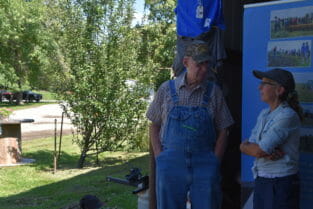
Melanie Peterson and her dad
Monday, September 10, 2018, Mark and Melanie Peterson hosted 49 guests at their farm near Stanton for a soil health field day. Mark started off talking about the farm’s history. The family who sold their farm to the Petersons in 2004, Dale and Sunny Nimrod, and Faith and Bill Sherman, were in attendance. Read more about this thoughtful farm sale here. Achieving their farmland goal of passing their farm to a local family resulted in the Nimrod family receiving Practical Farmers’ 2015 Farmland Owner Legacy Award. Read more about that here.
The Petersons have used cover crops for seven years. Mark says that in that time, soil tests have shown a 1% increase in organic matter. He said, “I’m comfortable covers are a big part of that increase. For every percent increase, the ground gains a one-inch increase in water-holding capacity. As we see more 100-year floods, and periods with no rain at all, this is vitally important.”
Adding small grains
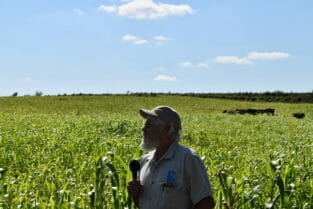
Mark Peterson standing in his multi-species mix with cattle in the background
More recently, the Petersons have added small grains into their production system. Mark commented that PFI’s small grains cost-share program provided additional incentive to plant small grains. The Petersons diversified their farm income stream by adding small grains, and also created unintended consequences. Mark said, “The first year we raised cereal rye for grain, I mentioned to a friend who is an officer in our local Pheasants Forever chapter that we were saving cereal rye for seed. He got all excited, and said, ‘Leave it until July, so you provide a nesting field for pheasants and quail.’” Mark said, “We’d be lucky if we heard one quail per year in 2004. Now, there are four separate coveys, two of which are more than 30 birds each.”
Multi-species covers
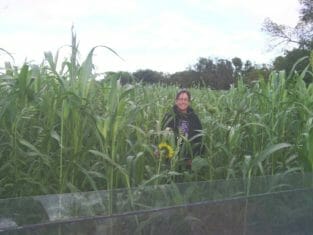
Melanie Peterson in first multi-species mix
Mark and Melanie planted multi-species covers on ground that was previously panted to wheat. “When you harvest a small grain like wheat in June or July,” Mark remarked, “it gives you the opportunity to do something like plant a multi-species cover crop. The soil in the area planted this year needed a jump-start. Putting so many species into a mix provides a lot of benefits to the ground.”
This is the Petersons third venture planting a multi-species cover crop mix. The first time they tried a multi-species cover, within 65 days, the cover grew taller than Melanie. Mark called Colton Catterton of Green Cover seed and asked, “What are we going to do with all this biomass?” Colton suggested Mark do a forage test. The test came back with a relative feed quality of 147. Since then, Mark has partnered with cattlemen to graze his cover crops.
“Those machines [cattle] out there are turning my cover crop into fertilizer,” commented Mark who has worked out a deal with his cattle-owning neighbor, Pete Marshall, to graze a multi-species cover crop mix that was planted after wheat harvest. Mark said, “Without kids interested in coming back, working with Pete is a way to get livestock back on the farm.” The 14-species cover crop mix, from Green Cover Seed, was planted in the second week of July. The seed cost between $20-25 per acre was drilled by Pete. At the field day, 20 cow-calf pairs were grazing on 55 acres, fenced into 4 acre paddocks. The cows are moved every two days.
Contract grazing
As for a contract grazing agreement, Mark paid for the seed and application, while Pete pays Mark a per-acre
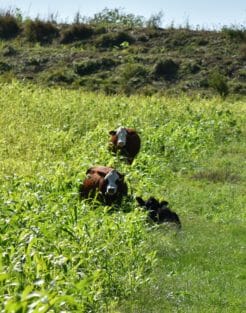
Cows in cover
payment and contributes his labor. The payment is minimal – enough to cover Mark’s costs. For those interested in contract grazing cover crops, this PFI factsheet provides some agreement considerations. Cover crops, especially those planted after a small grain, provide a multitude of benefits – maximizing your soil’s potential to form stable soil aggregates, uptake rainwater, build organic matter and provide cattle feed. When cover crops are grazed, short-term economic benefits can be realized, but keep in mind soil health benefits take longer to be seen. According to Mark, “multi-species cover crops are a multiple year investment.”
Multi-species over crop mix the Petersons planted (from Green Cover Seed)
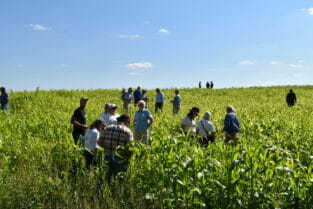
Attendees try to identify all 14 cover crop species
- 3 lbs sunnhemp
- 2 lbs mung beans
- 3 lbs sorghum sudangrass
- 1.5 lbs pearl millet
- 2 lbs forage sorghum
- 1.3 lbs daikon radish
- .4 lbs mustard
- .4 lbs purple top turnip
- 1.5 lbs sunflower
- 1 lb flax
- 3 lbs buckwheat
- 1 lb okra
- 15 lbs soybeans (from the farm)
Monitoring water quality
After attendees had a chance to walk through the cover crop mix, Theo Gunther from Iowa Soybean Association
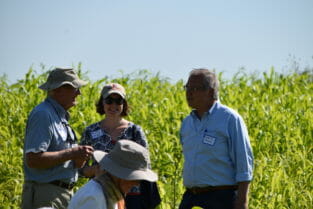
Dale Nimrod, Anna Johnson, and Congressman David Young make connections in the cover crop field
(ISA) talked about how cover crops impact water quality. Theo said, “My work focuses on trying to help farmers across Iowa improve water quality. A big part of that is knowing what their water quality is.”
Theo explained that cover crop benefits vary greatly depending on when they are planted and weather conditions. On average, cover crops reduce nitrate by 27% and nitrate N yield by 41%. Sites with cover crops average 4.7mg/L lower in nitrate concentration. Theo showed results of Mark and Melanie’s water quality tests. In most cases nitrates were below 10 mg/L, the federal standard for nitrate in drinking water.
Mark said, “A few years ago, when we got our annual 100-year rain, there were big ruts in the field. Melanie and I decided we had to do something about it. Cover crops and small grains help fill in the gaps of our warm-season corn and soy program, to get living roots in the ground year-round.”
Mark decided several years ago that they were done using anhydrous. “It was used in World War II to pack air fields. Plus, I don’t want to put nitrogen down that early.” Now he puts 40 lbs N down before planting with pre-plant chemicals, then 120-140 lbs N post-emergence. He is doing tissue testing on the grazed cover crop field to see if he can cut down more.
Looking toward the future
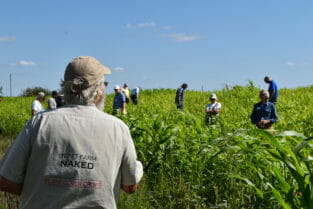
Don’t Farm Naked
Mark finished the field day with some thoughts toward the future. He showed a photo of his granddaughter and said, “It all comes down to this. I’m not comfortable with the legacy we’re leaving our kids. We really need to think about what shape the land will be in for them. We need to quit treating dirt like dirt, we have to treat it like soil.”
Mark and Melanie now are operating under this philosophy: “We are setting goals, and finding out what can we do that will work in our system to get us from here to there. Then, when we get there, we are not satisfied. We set a new goal.”
